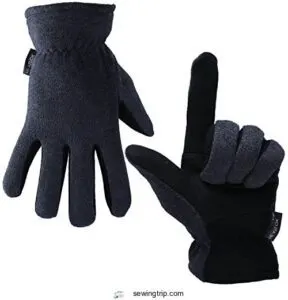This site is supported by our readers. We may earn a commission, at no cost to you, if you purchase through links.
 No, suede isn’t warm and definitely isn’t snow proof.
No, suede isn’t warm and definitely isn’t snow proof.
You’ll find yourself cold and soggy if you count on suede for winter protection.
This soft, porous material absorbs moisture like a sponge, making it terrible for snowy conditions.
While suede might feel cozy indoors, it lacks the insulation you need when temperatures drop.
Think of it as your fair-weather friend – great for mild autumn days but useless when winter shows its teeth.
The delicate nap that makes suede so appealing also makes it vulnerable to water damage and staining.
There are smart ways to work around suede’s limitations though.
Table Of Contents
- Key Takeaways
- Is Suede Warm for Winter?
- Is Faux Suede Warm?
- Are Suede Jackets Warm?
- Are Suede Boots Warm and Good for Winter?
- Is Suede Warmer Than Leather?
- Is Suede Snow Proof?
- Are Suede Boots Good for Snow?
- Can Suede Be Worn in The Snow?
- How to Winterize Suede Boots
- Warm or Cold Weather for Suede
- Warm Waterproof Winter Ski Gloves
- Frequently Asked Questions (FAQs)
- Conclusion
Key Takeaways
- You’ll stay cold and wet – Suede’s porous structure absorbs moisture like a sponge and provides minimal insulation, making it unsuitable for temperatures below 40°F or snowy conditions.
- Faux suede performs better – Synthetic versions with acrylic backing and polyester fibers trap heat more effectively than real suede, though they’re still not ideal for harsh winter weather.
- Waterproofing helps but isn’t foolproof – You can apply protective sprays and treatments to improve suede’s snow resistance, but these only work for light exposure and need frequent reapplication.
- Choose alternatives for serious winter conditions – You’re better off selecting wool, down-filled coats, or full-grain leather for reliable cold weather protection when temperatures drop significantly.
Is Suede Warm for Winter?
Suede lacks proper cold protection for winter weather.
This breathable material allows air circulation, making it unsuitable for temperatures below 40°F.
Suede’s porous structure offers minimal insulation against freezing conditions.
Your winter wardrobe needs denser fabrics with better heat retention.
Choose wool or down-filled coats instead for reliable warmth and cold weather protection, as they provide the necessary cold protection.
Is Faux Suede Warm?
When you’re exploring vegan fabrics for winter, faux suede stands out as a surprisingly effective choice. Unlike real suede’s porous nature, synthetic materials in faux suede create better heat retention. The acrylic backing and polyester fibers work together to trap warm air against your body.
Here’s what makes faux suede insulation effective:
- Synthetic fiber structure creates air pockets that retain body heat better than natural suede
- Thicker varieties with nap lining offer superior winter textures and warmth
- Less porous construction prevents cold air from penetrating through the fabric
- Layering compatibility works well under suede winter coats for extra protection
- Consistent thermal performance maintains faux warmth even in fluctuating temperatures
Quality matters substantially in faux suede cold weather performance. Thicker options with soft backing provide better suede insulation than thin, smooth varieties. You’ll stay warmer by choosing well-constructed pieces and layering them strategically with other insulating fabrics like fleece or wool. Faux suede is also a great option due to its stain resistant properties, making it a practical choice for winter clothing.
Are Suede Jackets Warm?
When choosing winter outerwear, you’ll find suede jackets offer moderate warmth for milder cold weather.
Suede insulation depends heavily on jacket construction and lining materials.
| Feature | Warm Option | Cold Option |
|---|---|---|
| Suede Weight | Thick, dense suede | Lightweight suede |
| Lining | Fleece or down filling | No insulation layer |
| Fit | Snug, wind-blocking | Loose, drafty gaps |
| Weather Limit | 30-40°F range | Below freezing temps |
Quality suede winter coats with proper suede lining provide decent warmth through fall and early winter.
The material’s natural breathability works against you in frigid conditions.
Dense suede warm clothing blocks wind better than porous varieties.
Your jacket’s effectiveness comes down to layering strategy.
Suede cold weather performance improves with thermal base layers underneath.
Winter fabrics like fleece linings transform basic suede into functional cold weather gear.
Understanding suede breathability summer conditions can help you make informed decisions about suede clothing in various temperatures.
Remember, suede jackets work best as mid-layer pieces rather than your primary defense against harsh elements.
Are Suede Boots Warm and Good for Winter?
Winter footwear choices can make or break your cold-weather experience. To address suede boots, the reality might surprise you.
Suede boots aren’t inherently warm – their warmth depends entirely on what’s inside. The suede exterior provides style but minimal insulation. Your feet stay cozy thanks to internal linings like faux fur, shearling, or recycled felt that trap body heat.
Suede’s warmth isn’t about the exterior—it’s all about what’s tucked inside those stylish boots.
Boot materials matter more than you’d think. Quality suede winter gear combines synthetic insulation rated for extreme temperatures, sometimes down to -40°F. Many manufacturers pair suede uppers with thermal barriers and moisture-wicking fabrics.
Suede insulation works best when layered properly. Thick linings create air pockets that retain warmth. Without proper insulation, even the finest suede offers little cold protection.
Winter care becomes critical with suede snow boots. The material’s breathable nature helps prevent overheating but requires treatments for moisture resistance. Cold weather protection comes from smart engineering, not the suede itself. To maintain your suede boots, you must follow a proper suede care routine.
Smart shoppers look for suede warmth through internal construction rather than exterior promises.
Is Suede Warmer Than Leather?
When comparing these materials, the science tells a clear story. Scientific testing shows goat suede leather has the lowest thermal insulation value at 0.402 m²˚C/W, while fur leather reaches 0.692 m²˚C/W.
This Suede Comparison reveals Leather Insulation consistently outperforms suede across all temperatures.
Fabric Warmth depends on fiber structure. Leather’s compact collagen fibers trap air effectively, creating superior insulation. Suede’s open nap allows air circulation, reducing heat retention. Think of leather as a tight sweater versus suede as a loose mesh.
Material Durability matters in harsh conditions. Leather blocks wind and repels moisture, maintaining its suede warmth rating. Suede absorbs water, losing insulation when wet. In freezing temperatures, fur leather provides 0.55-0.62 m²˚C/W insulation compared to suede’s lower performance.
Winter Fabrics should prioritize function. While suede offers style, leather delivers consistent suede cold protection. For dry, mild conditions, suede works. But when winter gets serious, leather wins the warmth battle hands down.
Is Suede Snow Proof?
Suede’s porous structure makes it vulnerable to snow and moisture penetration.
The soft, brushed finish that gives suede its luxury appeal also creates an open pathway for water absorption.
Without proper suede protection, your boots will quickly become saturated and damaged.
Even treated suede has limitations in snow conditions:
- Water repellent sprays provide temporary protection for only 2 hours of light exposure
- Specialized tanning processes like Repello offer better snow resistance but aren’t foolproof
- Deep snow or slush will overwhelm any protective treatment, causing permanent damage
Snow proof suede doesn’t truly exist.
While suede waterproofing treatments improve performance, they create water resistance, not complete snow protection.
Suede snow resistance works best with light flurries and brief exposure.
For serious winter conditions, choose full-grain leather or synthetic alternatives that offer genuine weatherproofing.
Are Suede Boots Good for Snow?
Your suede boots can handle light snow with proper care, though they’re not naturally snow-proof. Real suede absorbs moisture easily, making it vulnerable without protection.
Suede looks stylish but soaks up snow like a thirsty sponge—protect it or pay the price.
Here’s what you need to know:
- Apply waterproofing sprays regularly for suede snow protection and enhanced durability
- Choose lined boots with wool or fleece for proper winter insulation against cold
- Look for treated suede that’s been processed for better snow proof suede performance
- Maintain traction soles to prevent slips on icy surfaces during winter wear
- Dry thoroughly after exposure to prevent damage and maintain suede warm boots effectiveness
Suede boot care becomes critical in snowy conditions. Boot waterproofing treatments can substantially improve performance, though you’ll need reapplication every few weeks. Suede materials naturally breathe well but lack inherent moisture resistance.
For occasional urban snow walks, properly treated suede snow boots work fine. However, deep snow or prolonged exposure requires more robust winter footwear options. Understanding the snow damage risks is vital for maintaining your suede boots.
Can Suede Be Worn in The Snow?
Most people wonder if they can brave snowy conditions while wearing their favorite suede pieces. The short answer is yes, but it requires proper preparation and realistic expectations about the risks involved.
| Snow Condition | Suede Suitability |
|---|---|
| Light, dry snow | Manageable with protection |
| Wet, slushy snow | High risk of damage |
| Heavy snowfall | Not recommended |
Raw suede absorbs moisture like a sponge, making suede snow protection essential before venturing out. Without waterproof treatment, melting snow penetrates the material and causes permanent staining or texture damage. Cold weather alone won’t harm suede, but moisture will.
Your suede snow gear needs a quality waterproof coat applied beforehand. This creates a barrier that repels water while maintaining breathability. Suede maintenance becomes vital in winter conditions – you’ll need to reapply protection frequently. Investing in suede snow boots can provide additional protection and warmth.
Consider bringing backup footwear for particularly harsh conditions. While suede snow protection works, it’s not foolproof against extended exposure to wet conditions.
How to Winterize Suede Boots
Preparing your suede boots for harsh conditions requires strategic suede protection steps.
Follow these essential boot care techniques to create effective winter coatings:
- Clean thoroughly – Remove dirt with a suede brush before applying any suede treatment
- Apply waterproofing spray – Use specialized products designed for suede cold weather gear, covering all surfaces evenly
- Reapply protection – Multiple coats guarantee better resistance against snow and moisture
- Brush and restore – Gently brush to distribute treatment and maintain texture
This winterizing suede boots process transforms ordinary footwear into reliable suede snow gear that withstands winter’s challenges.
Understanding proper suede care products is vital for maintaining the quality and durability of your boots.
Warm or Cold Weather for Suede
Understanding which weather works best for suede can save you from fashion disasters and costly repairs. Your suede items perform differently across seasons, and knowing these patterns helps you make smart wardrobe choices.
Suede thrives in moderate temperatures between 30-60°F. Cold weather below 30°F challenges suede’s limited insulation properties. The material’s breathability becomes a liability when you need warmth retention. Hot weather above 80°F can cause discomfort due to suede’s heat-absorbing nature.
| Weather Condition | Suede Performance | Recommended Use |
|---|---|---|
| Spring (50-70°F) | Excellent | Perfect for jackets, shoes |
| Fall (40-60°F) | Ideal | Best season for suede |
| Winter (Below 30°F) | Poor | Requires heavy lining |
| Summer (Above 80°F) | Moderate | Light colors only |
| Rainy/Wet | Avoid | Water damage risk |
Suede durability depends on proper weather matching. Winter care becomes critical when temperatures drop. The material’s cold resistance weakens without protective treatments. Waterproof treatments help, but won’t transform suede into winter armor. Choose lined options for sustained cold exposure.
Warm Waterproof Winter Ski Gloves

Often, winter adventures demand glove materials that deliver both warmth and waterproof protection.
Quality ski gloves combine deer suede leather palms with advanced winter insulation technology. The hollow fiber construction traps heat while maintaining breathability for comfort during extended wear.
Therma polar fleece lining provides finger protection down to -20°F temperatures. This snowproof design guarantees reliable ski grip without sacrificing dexterity.
Hand warmers complement the insulation system for maximum heat retention. The suede palm offers superior grip control while remaining flexible in cold conditions.
These features make quality gloves essential for serious winter sports enthusiasts seeking dependable performance, ensuring they have the necessary tools for their adventures with advanced winter insulation technology.
Frequently Asked Questions (FAQs)
Does Suede keep you warm in the snow?
Suede performs poorly in snow, providing warmth only in temperatures above 30°F. Its porous texture absorbs moisture and lacks insulation. You’ll need waterproof treatment and warm lining for winter protection.
Is Suede a cold weather fabric?
No, suede isn’t ideal for cold weather. It’s breathable and porous, making it ineffective against freezing temperatures. You’ll need proper lining and waterproofing treatments to make it winter-suitable.
Can you wear suede in winter?
Surprisingly, you can wear suede in winter, but it’s not your best choice.
Suede isn’t naturally warm or waterproof—it’s porous and absorbs moisture.
You’ll need waterproofing spray and warm linings for adequate protection.
Can you use Suede in the Cold?
You can use suede in cold weather, but it’s not naturally warm or waterproof. Suede works best between 30-40°F with proper waterproofing treatment and warm lining for adequate protection.
Are suede boots good for cold weather?
Cold weather isn’t suede’s strong suit.
You’ll find suede boots only work well in temperatures around 30-40°F.
They’re porous and absorb moisture, making them unsuitable for snow.
You’ll need proper waterproofing and warm linings for adequate winter protection.
Can suede boots be worn in the snow?
Ironically, while suede’s porous texture makes it breathable and comfortable, it’s precisely this quality that makes it unsuitable for snow.
You shouldn’t wear suede boots in snow because they’ll absorb moisture and potentially suffer damage from the wet conditions.
Is it okay to wear suede in the snow?
You shouldn’t wear suede in snow. Suede absorbs moisture from melting snow, causing damage and staining. It’s porous and lacks waterproofing, making it unsuitable for snowy conditions despite proper care.
Is suede a winter material?
Like choosing the wrong gear for a mountain climb, suede won’t shield you from winter’s harsh bite.
Suede isn’t a true winter material since it’s porous and breathable, making it unsuitable for cold temperatures below 40°F or snowy conditions.
When should you not wear suede?
Rainy weather poses the biggest threat to suede since it absorbs moisture and can stain permanently.
You shouldn’t wear suede during heavy snow, wet conditions, or muddy environments where water damage is likely.
Can I wear a suede jacket in winter?
You can wear suede jackets in winter, but they’re not ideal for cold weather.
Suede isn’t inherently warm or snow-proof due to its porous nature, making it suitable only for temperatures around 30-40°F with proper lining.
Conclusion
Telegraph operators knew their dots and dashes, but modern fashion folks need different signals about suede’s winter performance.
You’ve learned that is suede warm and snow proof gets a hard no on both counts. Suede lacks insulation and absorbs moisture quickly.
However, you can winterize suede boots with waterproofing sprays and protective treatments. Choose leather or synthetic alternatives for serious winter conditions.
Save your suede pieces for dry, mild weather when they’ll actually serve you well.
- https://en.wikipedia.org/wiki/Suede
- https://www.britannica.com/science/winter
- https://www.defense.gov/News/News-Stories/Article/Article/2953765/allies-will-protect-defend-every-inch-of-nato-territory-says-secretary-general/
- https://www.onedirectionmusic.com/gb/home.html
- https://www.nytimes.com/wirecutter/reviews/best-touchscreen-gloves/













